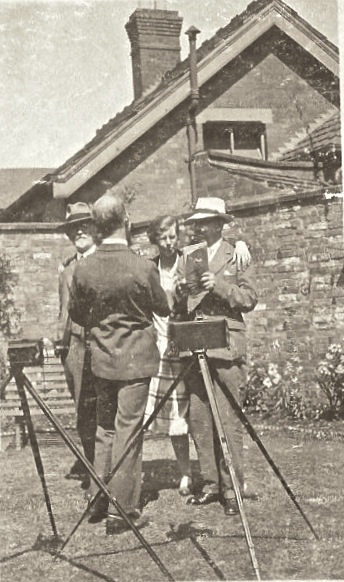Thomas Bruce Dilks By Katherine Dilks

by kind permission Mrs Wendy Washington
I am the granddaughter of Thomas Bruce Dilks and Agnes Isabel Thompson. Thomas was the son of Thomas Townsley Dilks and his wife Mary Eliza. Agnes was born in Bridgwater in 1875 was the youngest daughter of William Thompson and Agnes Magdalen Fitzroy Stuart. William Thompson was born at Street in 1837, was the oldest son of Francis James Thompson and Rebecca Stephens. Francis James Thompson was born in 1813 son of Joseph Thompson and Ann Clark.
Thomas Townsley Dilks, his wife Mary Eliza, and their eldest son Henry Lumley are all buried in one plot in Wembdon Road Cemetery, plot 838. TBD’s wife, Isabel, is buried with her father William Thompson and her brother H Stuart Thompson, plot 482. TBD married AIT in 1901.

to make way for the Eastover post office
I used to stay with my grandfather in Eastover, Bridgwater as a child and my memory of him is sitting over his manuscripts with a magnifying glass and a cupped hand as his sight had become so poor. He was agoraphobic and couldn’t leave the house. Meetings of the Oldmixon Club used to be held in his drawing room once a month. Meetings of the Quakers also took place there. He could get to his garden, but somehow this entailed going through the baker’s next door, so arrangements had to be made well in advance!
My home had an excellent portrait of him done by A B Connor of Burnham on Sea in 1945. The portrait of TBD hung in my parent’s home after TBD had died and everyone pronounced it an excellent likeness. We also liked the fact that he was holding a manuscript and his glasses. By 1945 he had very little sight left and this is probably the time I remember him with magnifying glass and cupped hand in his effort to read.

The table and desk still exist and I have an octagonal table with the same Victorian “country” carving which must have come from that room. I was told the desk was made from a church pew – I’m not sure if that’s at all relevant! My memory is that the table would be covered with his manuscripts rather than a vase of roses (which look as if they’ve seen better days!).
TBD’s father was a Wesleyan Minister. Wesleyan Ministers would change location every three years during their ministry, so the family were constantly on the move, never settling anywhere.
Thomas Townsley Dilks is recorded in a directory of 19th century ministers as being in Bridgwater between 1888 and 1891.
1847 Lerwick
1850 Aberdeen
1852 Greenock
1855 Dumfries
1858 Ramsey, Isle of Man
1861 Douglas
1864 Penrith
1867 Ashton-Lyne
1870 Leek
1873 Plymouth, King St.
1876 London, St. Geo.
1879 London, Hinde-St.
1882 Norwich
1885 Manchester, Grosvenor-street
1888 Bridgwater
1891 Clapham, Sup.
1894 Taunton, do.
TBD’s early life must have been shaped not only by his father’s profession but also by his position in the family. The youngest of four sons, he was even 8 years younger than his youngest brother. TBD’s older brothers, Henry Lumley, Christopher and Thomas Arthur, were all born in Scotland, whereas TBD was born in Penrith, just into England as his father worked his way South from preaching on the beaches in Shetland, via the Isle of Man and finally to Bridgwater.
TBD obtained the external London University degree of BA in 1884, and was a Fellow of the Royal Historical Society.
In 1901,TBD moved into 63 Eastover, Bridgwater and lived “above the shop” for the rest of his years. The basement, which was ground floor at the back, housed the printing works. On the ground floor, the shop was at the front, a small office in the middle and the type setting room at the back. Then the living quarters were on three floors above with three rooms on each floor. The rooms I remember best were his drawing room at the front, the kitchen and the dining room. As one entered the drawing room, there was the chess board set out for a game in progress, an upright piano where I’d be asked to play my latest piece, and finally around the corner would be sitting my grandfather with a rug wrapped round his legs, a manuscript on his knee, a large magnifying glass in his right hand and his left hand cupped to help his very poor vision. He sat by the fire where there was a large ornamental Victorian overmantel, his desk near at hand and a small, ornately carved table covered in manuscripts.
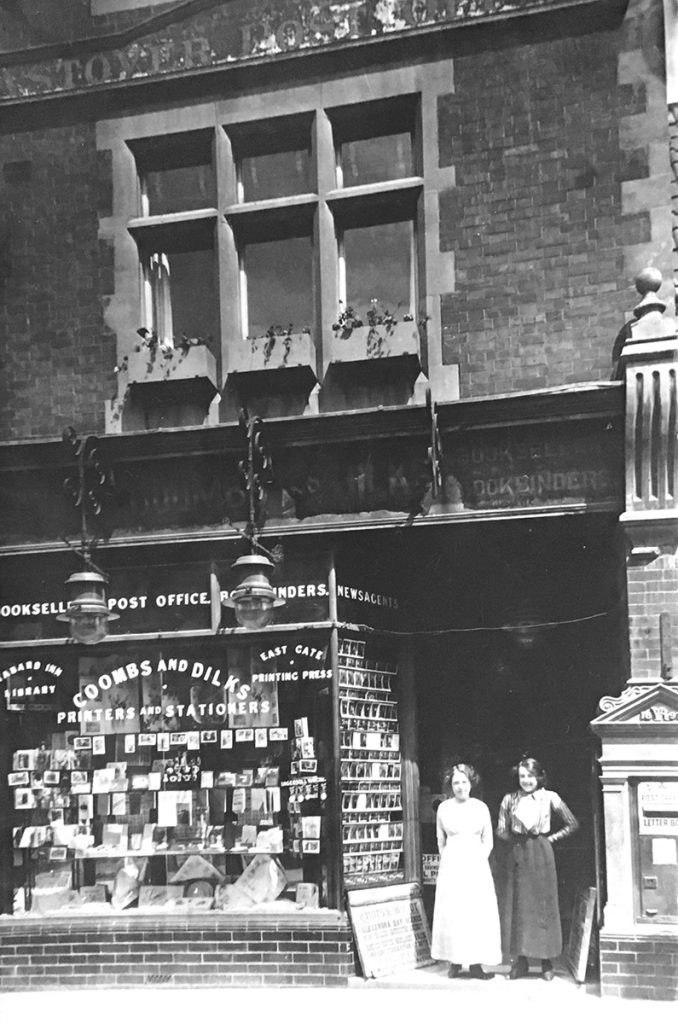
In the kitchen was a hay box. A stew was brought to simmering point after breakfast and buried under the hay. It was perfect at suppertime. Milk was delivered by horse and cart. The milkman had a large churn of unpasteurised milk. I would be sent down with two large jugs and would ask for an appropriate amount. The milk would be ladled in, sometimes still warm. However, all the milk had then to be boiled to sterilise it which took the edge off the flavour!
In the dining room was a blower instead of a bell, with whistle. It connected to the kitchen with one blow, and the shop with two!
The Printing works was run by a man was profoundly deaf and his speech was a series of grunts. I don’t remember his name, but to a small child he was fascinating and I was shown how to communicate with him; this was not at all difficult. He set the type and ran the presses. They mostly printed church magazines and the like. And, whilst other poets struggled to see themselves in print, my grandfather printed his own!
Through the printing works one approached the garden. It was the one outdoor space that my grandfather could manage. However, it was not easy to reach and if he decided it was a nice day and he would like to visit the garden, arrangements had to be made. Out of the door of the print room, across the courtyard. Knock on the door of the baker’s to seek permission. Walk through the bakery trying not to get covered in flour, across another courtyard, through a shed and we were in the garden. It was not large, but had four high brick walls and was beautifully kept with a lawn, flower beds and roses in abundance. This was where the only photos of him were taken, usually to mark some family occasion.
TBD was passionate about cricket and he had two cats named Eric and Alec after the Bedser twins. Both his sons shared this interest and played cricket, Jack being the more able. He batted for Somerset on a few occasions whilst my father bowled on fewer occasions for the minor County of Berkshire.
TBD’s life was governed by his agoraphobia and I was told this was why he bought the shop. I don’t know when he first became agoraphobic, or why. Was it because of the nomadic childhood or some more specific incident lost in the mist of time.
My father, Arthur Bruce, told me that once he announced he was better and thought he might visit a friend. My father was to go with him and they would go by taxi. However, the taxi had only started on its journey when panic set in and they returned home.
Another time he said he felt better and to everyone’s amazement said he would like to go for a walk if my father went with him. They walked and eventually sat on a bench together. He sat there happily chatting. They returned home, the walk a complete success, but he never managed to go out again.
Then there was the visit to hospital to have a cataract removed. An ambulance was to collect him. However, he was quite unable to get into the ambulance and had to be sedated to make the journey.
This operation in 1938 is remembered in one of his verses:
| To My Nurse ……… My children’s love, the surgeon’s wizard skill, And your wise care, dear Nurse, by God’s good will, Have given me back my sight, and soon – ah ! soon I shall once more behold a perfect moon, Sunsets and stars and the prismatic rain, And read my Keats and Wordsworth once again. |
TBD’s wife died in 1923 when she was only 48.
| Goodbye I am growing old and soon shall be Nought but an infrequent memory And then forgotten. Ere I sleep, Take, friends, these songs of mine to keep, Much have I loved and many a thing, But she, for whom I used to sing, Sleeps sound already, Sound sleeps Isabel, Sweet was she and incomparable, And with her end my songs. Farewell. |
And, round the nursery fire:
| A Charming Young Maiden A charming young maiden called Kate Is standing before a green gate, “Will you open it, please? Cause they’re all at their teas. I’m afraid they will think that I’m – not coming, you know!” |
His collection of poems were printed in four small volumes by the East Gate Press.
When I used to stay as a child, there was many an occasion when I was told to be quiet and was not allowed in the drawing room. Often a friend would be in playing a game of chess with TBD. At the age of 6, he patiently taught me the moves and we had many a game together. With the greatest of glee I sometimes won not knowing then that this was something grown-ups allow to happen!
TBD also taught me the Greek alphabet on one of my visits. I was surprised when I read Mathematics as part of my Education degree, to find not all students knew their Greek letters!
Although brought up as a Wesleyan, he probably converted to Quakerism when he met his wife in Bridgwater. As TBD was not able to leave the house, once a month on Sunday morning, Friends held Meeting in his drawing room.
Thomas Bruce Dilks was far more than the tradesman listed on the censuses. He was a classicist, a linguist, an historian, a poet, a chess player. He was passionate about cricket, natural sciences, the universe and a convinced Quaker. He had a keen sense of humour and was a loving and compassionate man.
St Mary’s Churchyard

The Funeral Directions given to Messrs J R Gilbert & Son record that Thomas Bruce Dilks of 63 (sic) Eastover died February 7th, 1949, aged 83 years. After cremation in Bristol, Arnos Grove, his ashes were to be interred at Wembdon Road Cemetery, presumably at the grave of his wife, plot 482. For some reason, St Mary’s churchyard was substitituted, where his ashes still lie, under a small slab bearing a small cross, unusually for a Quaker (see above). There are many of this pattern in that part of the churchyard, so maybe it was prescribed. Dilks left a bequest to the Society of Friends, or Quakers.
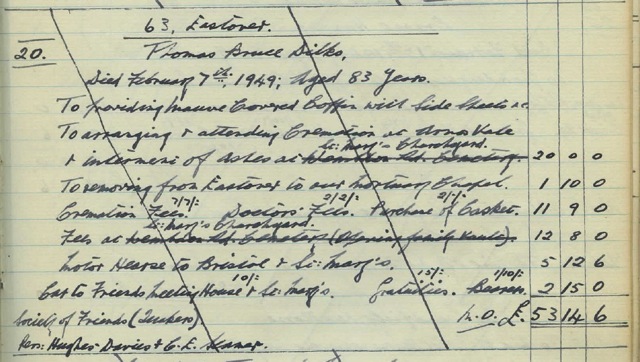
Family Trees

Photographs
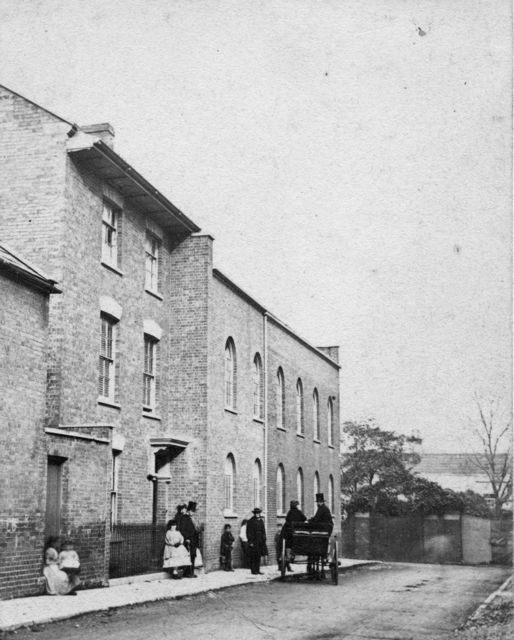
Is this picture of members of the Dilks family, where Thomas Townsley Dilks was minister?
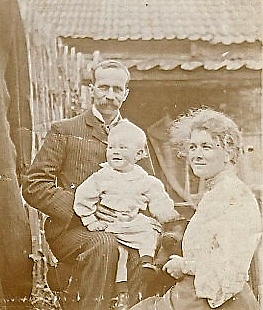

Thomas Bruce Dilks is the smallest standing just behind his mother
Front sitting, parents: Thomas Townsley Dilks, Mary Eliza Dilks (née Lumley)
Family Groups at 63 Eastover Bridgwater
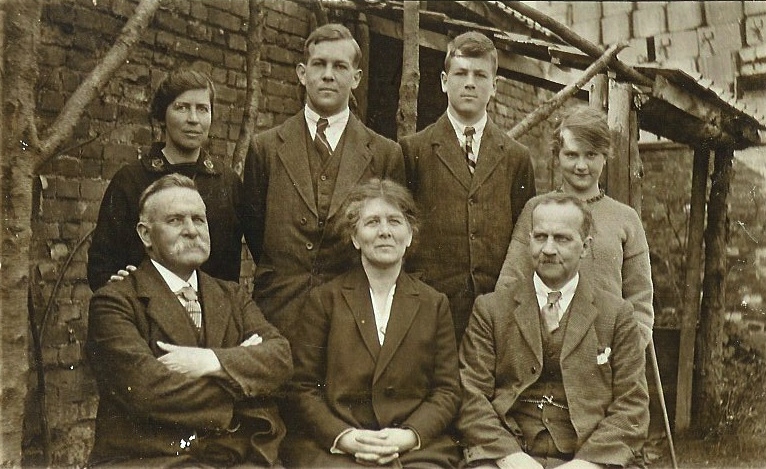
L to R standing: Lilian, Bruce, Jack, Peggy
L to R sitting: Henry, Isabel, TBD
Lilian = Constance Mary Lilian, HLD’s daughter
Bruce = Arthur Bruce, TBD’s elder son
Jack = John Stuart, TBD’s son
Peggy = TBD’s daughter
Henry = Henry Lumley Dilks, TBD’s brother
Isabel = Agnes Isabel Thompson, TBD’s wife
TBD = Thomas Bruce Dilks
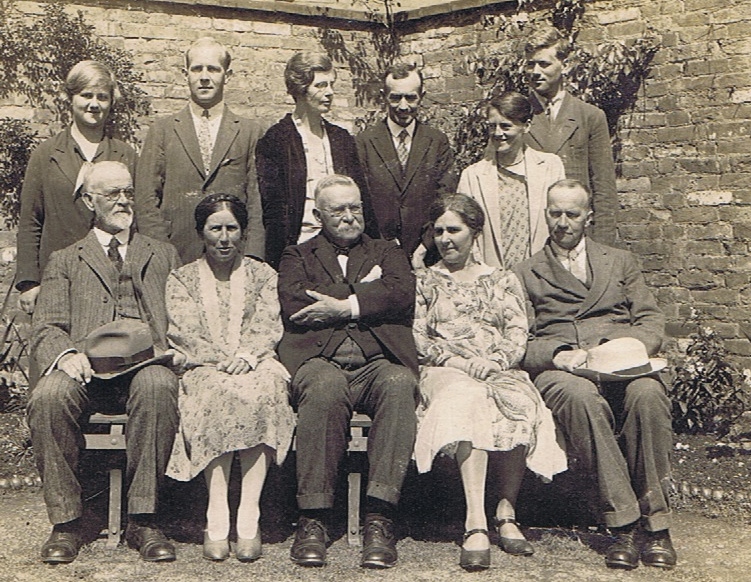
L to R standing: Peggy, Bruce, Irene, Leslie, Meg, Jack
L to R sitting: Arthur, Lilian, Henry, Jessie, TBD
Peggy = Margaret Isabel Dilks, TBD’s daughter
Bruce = Arthur Bruce Dilks, TBD’s elder son
Irene = Alice Irene Dilks, TAD’s daughter
Leslie = Harcourt Leslie Dilks, HLD’s son
Meg = Isabel Margarite O’Hanlon, Jack’s wife (probably fiancée at this moment)
Jack = John Stuart Dilks, TBD’s younger son
Arthur = Thomas Arthur Dilks, TBD’s brother
Lilian = Constance Mary Lilian Dilks, HLD’s daughter
Henry = Henry Lumley Dilks, TBD’s brother
Jessie = Jessie Poyser, Leslie’s wife
TBD = Thomas Bruce Dilks

John Stuart Dilks (served in RAF)
Sitting: TBD On ground: Isabel Katherine and Pamela Margaret (TBD’s grandaughters) in 1939
